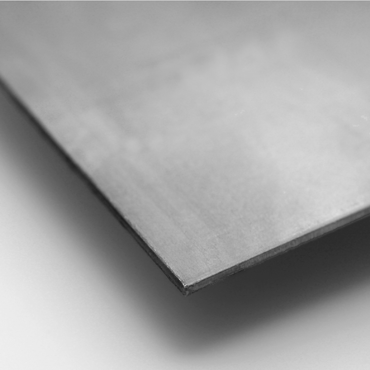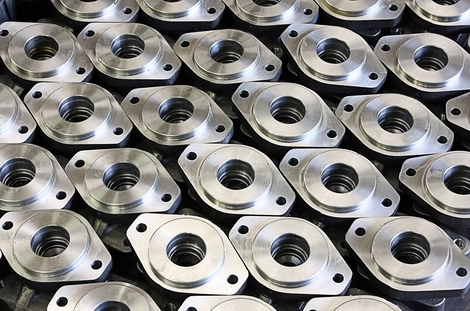What is DC01 Steel? -Properties, Machining, Comparison
 Aug 23,2025
Aug 23,2025

Need a steel alloy that meets all the demands of your precision machining product? DC01 steel is the answer. It is a galvanized steel with high strength and durability. There are many other interesting features about this steel that are covered in this article in detail. So, let’s get started!
What Is DC01 Steel

DC01 steel (EN10130, 1.0330) is a rolled low-carbon steel. It has high formability and smooth surface and low carbon steel content in its compositions helps in easy deformation and welding. It is a well-known material for the applications of deep drawing, stamping, and other forming processes.
Definition and Naming
1.0330 is a European standard to denote a cold rolled and non-alloy steel grade. It is used for cold forming and has good surface quality. "Cold rolled steel (CR) for forming" is the shaping process of steel at room temperature which gives precise dimensions and a smooth surface finish. The HR (hot-rolled) steel is done at high temperatures and has scaled surface and less precise dimensions.
What are Low-Carbon Steels?
Low-carbon steels are a type of steel with very low carbon content. Normally it is less than 0.25% and makes the steel more ductile and malleable. DC01, DC03, and DC04 are examples of cold rolled low-carbon steels. They all have high formability but DC04 has better deep-drawing properties than DC01.
Chemical Composition of DC01 Steel
The chemical composition of 1.0330 DC01 material is as follows:
|
Elements |
Percentage |
|
carbon |
≤0.12% |
|
manganese |
≤0.60% |
|
phosphorus |
≤0.045% |
|
sulfur |
≤0.045% |
|
silicon |
≤0.03% |
|
nitrogen |
≤0.008% |
|
aluminum |
≤0.02% |
|
copper |
≤0.20%. |
Nominal Chemistry
The nominal chemistry of each element in the 1.0330 DC01 material are as:
- Carbon (C): is very low in composition.
- Manganese (Mn): is a deoxidizer.
- Phosphorus (P): reduces weldability.
- Sulfur (S): increases brittleness.
- Silicon (Si):is also a deoxidizer.
- Nitrogen (N): affects strength and toughness.
- Aluminum (Al): is also a deoxidizer.
Role of Elements
- Carbon is the main element and increases formability without cracking.
- Manganese increases strength, hardness, and wear resistance.
- Phosphorus increases strength but reduces ductility and weldability.
- Sulfur increases machinability and decreases ductility and weldability.
- Silicon increases strength.
- Nitrogen affects the mechanical properties.
- Aluminum influences grain size.
- Copperenhances corrosion resistance.
Chemical Composition
Elements
Mechanical and Physical Properties of DC01
DC01 steel properties involve high formability and weldability. It has high tensile strength and yield strength. These features make it an ideal choice for different cold-forming applications. The low carbon steel content also increases its weldability.
Strength and Elongation
The strength and other DC01 steel properties are:
- Strength:it has tensile strength of 270-410 MPa.
- Elongation:minimum elongation of 28% means good ductility.
- Yield Strengthis typically around 280 MPa.
- Elasticity:Young's modulus is around 200GPa.
Formability Indices
Ductility and tensile strength of 1.0330 DC01 material increases its ability for cold-forming processes like drawing and bending. It is a versatile material for general forming operations. But for complex shapes, other materials like DC05 or DC06 are used for their higher ductility.
Thermal, Magnetic, Electrical Data
The thermal conductivity of1.0330 DC01 material changes with the temperature. But the normal range is 14.3-31.2 W/m·K. its specific heat capacity is 112 J/kg·K. DC01 is a ferromagnetic alloy and also has consistent electrical conductivity with other low-carbon steels.
DC01 vs DC04 Cold Rolled Steel
These are both cold rolled steel and an unalloyed steel. Both have distinct properties and applications but DC04 has better deep drawing capabilities. Therefore, it can make more intricate shapes and DC01 is used for general cold forming applications.
Material Properties Difference
The chemical composition of both steels is almost the same. But DC04 has lower C, Mn, P and S content which increases its deep drawing characteristics.
DC04 has lower yield strength and higher elongation than DC01 and can deform easily without cracking. It has higher elongation and better anisotropy (r90) and hardness. This means it can withstand more deformation before fracturing.
The difference between the mechanical properties of DC04 and DC01 are as:
|
Mechanical properties |
DC01 |
DC04 |
|
Tensile strength |
≤ 280 MPa |
≤ 210 MPa |
|
Yield strength |
270-410 MPa |
270-350 MPa |
|
Elongation |
≥ 28% |
≥ 38% |
Applications Difference
DC01 is good for general cold forming application such as bending, embossing, and simple drawing. It works best intricate shapes are not required. It is mostly used in structural components and housing. It can be used in specific parts that do not need extreme deep drawing.
While DC04 is used for deep drawing applications. It can make complex shapes, intricate shapes and deep-drawn parts like automotive body panels and appliance parts. It is used in appliances like washing machines or refrigerators. It is also used in electrical products and packaging.
When to Use DC04 Steel?
If you are not sure how to decide the use of DC04 steel, here are quick tips for you:
- For the application needs high deformation and shaping without cracking.
- For complex parts or deep drawing parts.
- For high precision and dimensional accuracy.
- For more intricate shapes.
DC01 Steel vs S235 Structural Steel
These are low carbon steels but have different and distinct properties. DC01 is cold-rolled steel and has high formability and smooth surface. It is mostly used in applications like automotive panels and appliances. S235 is a hot-rolled structural steel and has high strength and stability in load-bearing applications like construction structures.
Material Properties Difference
DC01 has less than 0.12% carbon level and has higher ductility, good for bending, stamping, and deep drawing. Its tensile strength is 270-410 MPa.
While S235 has higher carbon and manganese content than DC01 and thus has higher r strength. Its yield strength of 235 MPa with better structural stability and load-bearing capacity.
Applications Difference
DC01 is used in body panels, chassis parts, and structural reinforcements. It is also used in washing machines, refrigerators and in construction of roofing, cladding, and other non-load-bearing structural elements.
S235 is used in building frameworks, bridges, and other load-bearing structures. It is used in machinery parts and equipment and for military vehicles (in some cases) due to its high explosion resistance.
|
Feature |
DC01 (Cold Rolled) |
S235 (Hot Rolled) |
|
Processing |
Cold-rolled |
Hot-rolled |
|
Surface Finish |
Smooth |
Rougher |
|
Formability |
High |
Medium |
|
Strength |
Lower strength |
Higher |
|
Typical Applications |
Automotive, appliances, furniture |
Construction, infrastructure |
DC01 Steel in CNC Machining
DC01 is suitable for CNC machining due to its higher formability and weldability. Machining can be carried out with any traditional methods like milling, drilling, and tapping.
DC01 Machinability
DC01 has lower strength so it is better to use appropriate cutting tools and parameters of cold-rolled steel. The CNC machining procedure that can easily be carried out on DC01 is explained below:
Milling DC01
1.0330 DC01 material can easily be milled. For better surface finish, climb milling is recommended. Climb milling is using the cutter rotating in the same direction as the feed. It gives smoother surface finish and longer tool life than conventional milling.
Drilling and Tapping DC01
DC01 is used in cold forming applications because of its complex shapes and design. Drilling and tapping are simple processes for DC01 because it is low carbon steel and has good machinability. Drilling and tapping are the processes of making threaded holes in the material. It is done by a combination of drilling and tapping operations. Therefore, it has a specific type of tap called a "DC tap".
Surface Finish and Deburring
After drilling or milling, deburring of edges of the part is a common practice to remove any sharp edges. Because this can be hazardous or interfere with following operations and it ensures safety and prevents issues with subsequent processes or end-use. And the surface finish quality is graded as DC01-A or DC01-B. DC01-B is a defect-free surface suitable for high-quality coatings.
Other Manufacturing Methods of DC01 Steel
DC01 steel has chemical composition that makes it suitable for all kinds of traditional manufacturing methods. It offers good surface finish and smoother surface from all these processes.
DC01 Steel Forming
Low carbon content makes it malleable and ductile. This allows to form DC01 steel very easily with bending, stamping and to make complex shape easily without being deformed or cracked or losing stability. DC01 is suitable for:
- Bending: to form steel along a straight line.
- Stamping: to create shapes by pressing it with a die.
- Shallow Drawing: Forms the steel into some shallow shapes.
- Embossing: Creates raised patterns on the surface.
- Beading: Creates a rounded ridge.
DC01 Steel Bending
Bending, deep drawing and stretching processes are common in processes in manufacturing. And DC01 gives good results with all these manufacturing processes. All techniques create high surface quality, which is important for many applications. For example, automotive and appliance manufacturing, where aesthetic is the one of the main features.
DC01 Steel Welding and Joining
This steel can easily be weldable using various methods such as spot welding, MIG/MAG welding, and laser welding. DC01 is also easy to join with other structures with different methods like welding, brazing, and soldering and is flexible in joining techniques.
Benefits of Using DC01 Steel as CNC Material
DC01 is highly beneficial for CNC machining due to its low carbon content. It is also affordable than many higher carbon steels and stainless steels.
Better Machinability
DC01 has high machinability and can easily be cut and shaped through CNC machining. It offers faster production and less tool wear due to low carbon content and high malleability. This highly formable steel can be created into complex geometries without affecting its structural integrity.
Excellent Surface Finish
This Cold-rolled steel naturally has a smoother which helps in minimizing the need for additional finishing processes.
More Affordable Choice
DC01 is more cost-effective than other tool steels, stainless steel and all the high carbon steel due to no tool wear, no need of additional finishing process. And most importantly it offers good weldability to be easily joined with other components through welding techniques and easy to handle with other manufacturing processes.
Common Applications for DC01 Steel

DC01 offers many advantages due to its versatile nature and therefore it is used in a variety of applications. Some of them are as:
Appliance Enclosures
It is often used in outer casing of the household appliances like refrigerators, washing machines, and ovens. It also has good surface finish and formability which makes it easy to make desired shapes and aesthetics for these products.
Automotive Sheet Components
DC01 is used in manufacturing different interior brackets in automotive. This provides structural support and holds components in place. Its strength and formability are suitable to make pedal brackets that can withstand stress and pressure. It is also used in mounting plates for automotive cars and can fix various components and provide a stable platform.
Mounting Plates
DC01 is also used in construction of mounting plates for applications other than automotives cars like electrical industries. These plates serve as a base to attach the other components and to provide stability and structural integrity.
Conclusion
DC01 steel is a cold rolled steel. It has low carbon content which increases its formability, weldability, and moderate strength. It has common uses in applications which need cold forming, like automotive parts, appliances, and furniture. DC01 has better surface finish and formability when it is being compared to structural steels like S235. However, low carbon steel content decreases its hardness and strength than other carbon steels and stainless steel.
DC01 is suitable for simple forming operations like bending, shallow drawing, and stamping. When machining DC01, consider its lower strength and use appropriate cutting tools and parameters of cold-rolled steel for better results.
For more information about the CNC machining of DC01 steel according to specific grades and applications, contact TUOFA custom metal machining today!
FAQs on DC01 Steel
Is DC01 the same as CR4?
Yes, 1.0330 dc01 material is the standard designation by European standards (EN 10130). And CR4 is used to refer to the same steel grade in the steel.
What is DC01 steel equivalent to?
DC01 steel equivalent to many other standards such as SAE1008, SAE1010, St12, FeP01, and SPCC.
Is DC01 a stainless steel?
No, DC01 is a low carbon steel and is a cold-rolled steel grade.
 Tel/WeChat:
Tel/WeChat:  Email:
Email: 
 Home
Home
 Nylon vs. Polyester: A Complete Engineering Plastics Guide
Nylon vs. Polyester: A Complete Engineering Plastics Guide 







